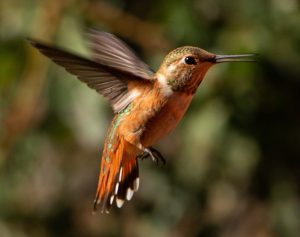We have a few resident hummingbirds who battle over our feeders. The current kings of our two feeder domains are both male Anna’s hummingbirds, recognizable by their gleaming ruby heads.
However, there are a couple of times a year when even our resident bullies get their comeuppance and are chased away. The gypsy kings that fly through, full of fight, are Rufous hummingbirds. These birds are considered one of the most aggressive hummingbirds in North America.
Surprisingly, these feisty birds are smaller than the Anna’s hummingbirds they quickly chase off. The Anna’s range from 3.9 to 4.3 inches while the Rufous ranges from 2.8 to 3.5 inches, almost an inch difference. My guess is it’s their attitude that makes the difference for these Rufous ruffians.
The reason that these bronze bullies don’t rule the roost in the Sierra foothills is that we only see them during migration. Starting in Mexico in spring, they fly north through California. Some fly as far as southern Alaska. Breeding in coniferous forests, some stop in Humboldt, while others spread out into Oregon, Washington and Canada. The hardiest continue on to Alaska. In the foothills, we only see a few because the main spring migration path is along the coast and inland valleys.
These little birds make one of the longest migrations in the avian world, a 3,900-mile one way journey! The return migration moves eastward, spreading from California to the Rocky Mountains. This is when we really get to see them here in the foothills. Starting in August and into September, they move south. We have seen up to a dozen birds at a time gathering around a feeder.
Attracting Rufous hummingbirds is, fortunately, the same as for almost all species common to California. Think about the three basics: food, water and shelter. A water source, like a small fountain, with moving water to prevent mosquitoes, will certainly do.
While a sugar water feeder will attract birds, they need natural flower nectar. Plan for a full four-season bloom with water-thrifty native plants. In the foothills, we can fall back on manzanita for winter blooms. In spring, sticky monkey flower and hummingbird sage come to mind. In the summer and fall, California fuchsia is a red trumpet-shaped flower that seems to really attract hummers.
The third leg of this tripod is shelter. Trees and lower shrubs provide both high and low cover. Many hummingbird species make their nests in lower layers of cover, so provide some protection from cats, those most-efficient hunters. Another thing that surprised me is that hummers need spider web to bind their nests together. Spider silk gives the nest elasticity to expand for the growing chicks.
Hummingbirds can easily be habituated to human beings. One little female flew right up to my wife and hovered for a while about a foot away, a wonderful experience. We are eagerly awaiting the three-ring-circus arrival of the Rufous rowdies this year. When they arrive en masse, they truly earn their group name – a “jewel” of hummingbirds.
Jim Bliss is a University of California Cooperative Extension Master Gardener of Tuolumne County.

